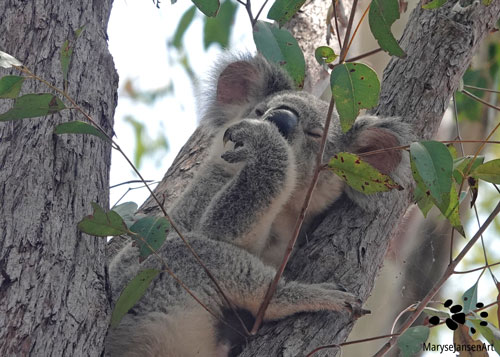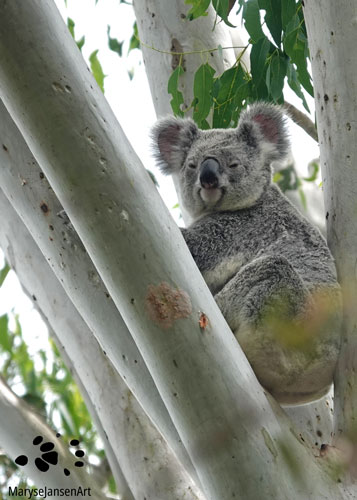Wildlife Photography with marysejansenart
Spot a koala and learn all about this amazing animal

Table of Contents
Sighting of the now listed as endangered Koala
Last month, finally, the koala has officially been listed as endangered in Queensland, New South Wales, and the ACT. A good reason to put koalas in the spotlight! I’m going to share 9 interesting facts about koalas with you today.
And there’s more: if you’ve read my article about the wildlife spotting and/or saw my video about my World Wildlife Day Walk, you would understand my feeling of elation when spotting a koala that I can share on video with you so soon after! It was almost as if the forest had heard my call!
I’m just doing another walk in the bush and, as I explained in my article about wildlife spotting I am always aware of the possibility of seeing a koala, but at the same time I keep my senses open to anything that crosses my path during my walks. I am welcomed by a Brush Turkey this time! I’m enjoying the birds and the butterflies, always scanning my surroundings. Always looking high and low. And suddenly it’s there: a koala! It’s having a snooze, it’s bottom wedged in the fork of a Gum Tree, which is the most common way you will see them since they spend most of their time sleeping!
When you observe koalas some questions may rise, such as why do they sleep so much? I hope the following 9 interesting facts about koalas will answer some of these questions! But first, watch here the video of my walk and be ready for a few surprises!
Fact #1 – Koalas have a hard bottom
Now, about these bottoms… Have you ever wondered how a koala could seem so comfortable sitting in the trees like that?
They have a lot of cartilage at the end of their spine which makes their bottom really hard. Therefore it’s not so sensitive and they can easily last sitting for many hours on a hard, uncomfortable surface! Very handy for a life in the trees!
Fact #2 – Koala paws have opposing digits and fingerprints!
Did you notice those interesting looking paws on the featured photo or in the video? Their strong claws also serve them well during their life in the trees. Like human hands and feet, koala paws each have five digits. The way human hands have a thumb opposing four fingers, koala front paws have two digits opposing the other three! This way they have great grip when climbing trees! On the hind paw, digits two and three are fused together. This large digit helps them with grooming.
Rough pads on the undersides of the paws give them even more grip on those tree trunks. On these pads are lines and fingerprints, just like humans have! In fact, the koala is the only animal (other then primates) that has these kind of fingerprints. They can be used to identify individual koalas!
Fact #3 – Koalas have a strong sense of smell
The patterns on the big leathery nose that is so characteristic for koalas provide another, easier way to identify individual koalas.
These big noses have sensitive hairs on them which allow the animal to detect the slight variations in smell of the Eucalyptus leaves that make up their diet. This way they can differentiate the levels of toxins in each leaf. This is very important because the chemical make up of each leaf varies and they need to pick the leaves with more water and less toxins to be able to survive. You can imagine why they are such picky eaters!
Fact #4 – Koalas are picky eaters
Koalas eat only one thing: Eucalyptus leaves. These leaves have a very low nutritional value and are high in toxins. And each leaf needs to be analysed by smell to see if it’s suitable to eat. From the 700 species of Gum Trees that we have in Australia there are only 50 edible for them. Most of these are ‘sometimes food’, only 12 species are eligible to be part of their staple diet.
An individual koala will have a preference for two or three of these. They will frequently visit the trees of those few species within their territory in search of the best leaves of the day. As described in my article on Koala Spotting, popular koala trees can be recognized by the scratch marks on their trunks.

Fact #5 – How the koala processes its toxic diet
Even though koalas select the leaves they eat so carefully, they still ingest a lot of toxins, So their digestive system has to deal with that! The liver is partly responsible for the detoxifying process. The part of the intestines called the caecum is largely developed in koalas. The bacteria that live in the caecum help break down toxins as well as fibers. The leaves are very fibrous and even with the help of the caecum the koalas can absorb only a small amount of their food. Therefore they have to eat a lot, 500-1000gr of leaves each day!
It’s hard work for getting very little nutrition so now you can understand why they sleep most of the time, up to 18 hours a day!
Fact #6 – A koala’s home
Koalas are solitary creatures. A koala’s ‘home’ spans an area in which they find their favourite trees, called a ‘home range’. The size of such a home range can vary greatly, obviously depending on the abundance of food trees. But that’s not the only thing that determines the size of their territory. The density of the population, sex, age and social position all play a role. The home ranges do overlap with each other, that way it’s possible for them to make contact during the mating season.
Fact #7 – Male koalas have a scent gland and a terrifying mating call!
Male koalas have a scent gland on their chest, which is visible as a dark mark. They rub their scent on tree trunks to mark their territory. When it comes to mating season the males begin to call to let other koalas know about their presence. The sound they make is a deep bellowing, grunting sound. It carries quite far in the night.
I remember hearing this sound every night after just arriving in Australia. I had no idea what is was but it sounded quite disturbing! Can you believe my surprise when I saw on TV that these noises are produced by those cute, fluffy koalas!
Females can make a similar noise, to let the males know that they are ready to mate. When they begin to scream or wail however, they might not be so impressed with the male’s advances. This is their distress call.
The males will fight other males to gain dominance over the home ranges of a number of females.
Fact #8 – Koalas live 10-15 years in the wild
Koalas in the wild normally live for 10-15 years. The males live for about 10 years and the females can get older and live up to 15 years. They don’t have many predators. Young koalas are hunted by large birds of prey. Occasionally koalas will be taken by Eagles, Owls or Goannas. They are most vulnerable when on the ground, where a Dingo (or a dog) could attack them. They walk very awkwardly but if needed can break out into a sprint. They are also capable of swimming if necessary.
Fact #9 – The difference between northern and southern koalas
There is only one species of koala, but there are definitely differences between the northern and the southern form. Northern koalas are found in Queensland and northern New South Wales. Southern koalas can be found in New South Wales, ACT, Victoria and South Australia. You can spot some southern koalas in this video.
The northern koalas are a lot smaller than the southern koalas. In the northern areas, an adult female weighs 5.5kg on average and males weigh about 7kg. In the south however, a female can weigh 8.5kg and an adult male up to 12kg!
All koalas have a thick woolly fur which protects them from heat, cold and rain. The fur of northern koalas is a lot less thick and lighter in colour than that of southern koalas. In the southern areas of Australia the winters are a lot colder so the koalas there need a thicker coat!
The koalas in my images are mostly northern koalas, spotted in south-east Queensland. There are a couple of images of southern koalas as well, photographed in South Australia. When you purchase a print of an image as seen in this article or any of my other koala photos I will donate 50% of my proceeds to the Wildlife Warriors’ Koala Conservation Project. Please visit my ‘Save the Koala Collection‘!

Did ‘9 Interesting Facts about Koalas’ answer your questions about koalas? Let me know in the comments what you’ve found interesting and if you have any additional questions!


